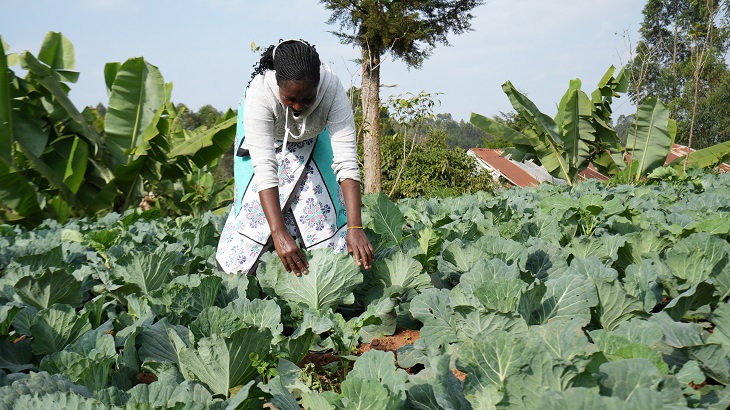From Hoe To Handset: How Kenya’s Smallholder Farms Are Turning Into Tech-Powered Businesses

Kenya’s small-scale farming sector is undergoing one of the most important but under-reported transformations of our time: the slow, steady migration from analog practices, seed bought at a market stall, advice from a neighbor, to digitally enabled, data-driven agriculture. That shift is not an abstract promise; it is happening now, driven by a new crop of agritech firms, new financing models from development finance institutions, and pragmatic farmers who are voting for efficiency with their wallets.
Shamba Pride, a Kenyan agritech company that has scaled a “DigiShop” network to bring inputs, advice, and last-mile distribution to smallholders, is a useful case study in how this transition works and why support from institutions such as the European Investment Bank (EIB) matters.
For decades, the constraints that held back yields for Kenya’s smallholders have been simple: unreliable access to quality inputs, fragmented distribution, weak extension services, and information asymmetries around timing, dosage, and market demand. Technology is not a panacea for those problems, but it changes the economics and the incentives.
As Samuel Munguti, the CEO and Founder of Shamba Pride, puts it, “Many small-scale farmers in Kenya have limited to credible, affordable, quality agriculture inputs, access to markets, as well as access to training services.” According to him, it is only through the embrace of tech that the real revolution in small-scale farming will be realized.
There is no doubt that digital platforms aggregate demand, stabilize supply chains, and improve transparency. When a farmer orders seed or fertilizer through a digital hub and chooses cash-on-delivery, the cost and risk of stocking rural agro-dealers fall. When field agents are equipped with apps that record soil type, input usage, and yields, the resulting data enables targeted recommendations and credible proof-of-impact that investors and buyers can use.
Shamba Pride’s model, franchised DigiShops, a merchant network, and tech-enabled logistics and field support — demonstrates these dynamics in action. Its recent capital raises have been used to scale merchant networks and a physical supply-chain center to improve fulfillment.
Startup innovation needs capital, not just grant financing but risk-tolerant equity and subordinated debt, to build operations that can serve millions of dispersed smallholders at low margins. That’s where initiatives such as Boost Africa and EIB-backed vehicles come in.
By providing capital to fund managers and early-stage funds, and by co-investing alongside private partners, these institutions lower the cost of capital for agritech firms and signal credibility to commercial investors. Boost Africa’s mission to channel venture capital and technical assistance into young African businesses directly tackles the financing gap that prevents scaling.
Boost Africa is explicitly aimed at increasing both access to finance and technical support for early-stage, innovative African entrepreneurs, as well as Fund Managers with a strong focus on agriculture, climate, inclusion, etc. That kind of strategic mission aligns strongly with what Shamba Pride is doing, so there is a high “multiplier effect”: the funding doesn’t just flow, but enables transformation of business models that can generate systemic changes.
In practical terms, Seed investors and blended-finance facilities fund the construction of logistics infrastructure and digital platforms; that infrastructure reduces per-customer service costs and allows companies like Shamba Pride to reach more farmers sustainably. The EIB’s engagement in backing fund managers and initiatives that invest in Shamba-type businesses magnifies the impact, not just through money but via governance, due diligence, and market linkage.
What are the concrete benefits?
The transformation is measurable. Digitally enabled distribution reduces stock-outs and counterfeit inputs; better inventory management brings down prices and increases reliability. Field advisory delivered through mobile and agent networks shortens the learning curve for adopting best practices and new, climate-smart seeds or fertilizer blends. For agribusinesses, digitization creates traceability and aggregated volumes that make them attractive to buyers, processors, and off-takers.
Shamba Pride’s scaling illustrates a virtuous cycle: better logistics and merchant networks mean more farmers served; more farmers served generate more transactions and agronomic data; that data lowers risk for lenders and input suppliers, which in turn unlocks cheaper inputs and credit, and so on. The model also shows how physical and digital solutions must be stitched together: a DigiShop is just as much about a trained shopkeeper and a reliable supply chain as it is about an app.
What are some of the challenges facing the sector?
The shift to tech is neither even nor automatic. Several constraints must be tackled for the gains to become widely inclusive:
- Digital literacy and trust. Many smallholders need training and simple UX design; trust is earned through reliable delivery and tangible improvements in yields.
- Payments and affordability. Interoperable mobile payments and micro-credit tailored to cropping cycles are essential.
- Infrastructure and last-mile costs. Road, cold-chain (where needed), and decentralized storage remain expensive. Public-private co-investment in rural logistics hubs can reduce unit costs.
- Regulatory clarity on digital credit, data privacy, and input quality. Governments must protect farmers from predatory lending and counterfeit products while enabling fintech innovation.
Policy-makers and development partners can focus on catalytic interventions that unlock private capital rather than crowd it out: subsidized technical assistance for fund managers, outcome-based grants for last-mile infrastructure, and regulatory sandboxes for digital insurance and credit.
The truth is, technology does not replace the farmer; it multiplies her options. The right mix of capital, sensible regulation, and ground-level operational models can turn Kenya’s millions of small plots into a resilient, productive, and digitally connected backbone for the country’s food system. The EIB and initiatives such as Boost Africa are not ends in themselves; they are accelerants.
About Soko Directory Team
Soko Directory is a Financial and Markets digital portal that tracks brands, listed firms on the NSE, SMEs and trend setters in the markets eco-system.Find us on Facebook: facebook.com/SokoDirectory and on Twitter: twitter.com/SokoDirectory
- January 2025 (119)
- February 2025 (191)
- March 2025 (212)
- April 2025 (193)
- May 2025 (161)
- June 2025 (157)
- July 2025 (227)
- August 2025 (211)
- September 2025 (270)
- October 2025 (297)
- November 2025 (230)
- December 2025 (162)
- January 2024 (238)
- February 2024 (227)
- March 2024 (190)
- April 2024 (133)
- May 2024 (157)
- June 2024 (145)
- July 2024 (136)
- August 2024 (154)
- September 2024 (212)
- October 2024 (255)
- November 2024 (196)
- December 2024 (143)
- January 2023 (182)
- February 2023 (203)
- March 2023 (322)
- April 2023 (297)
- May 2023 (267)
- June 2023 (214)
- July 2023 (212)
- August 2023 (257)
- September 2023 (237)
- October 2023 (264)
- November 2023 (286)
- December 2023 (177)
- January 2022 (293)
- February 2022 (329)
- March 2022 (358)
- April 2022 (292)
- May 2022 (271)
- June 2022 (232)
- July 2022 (278)
- August 2022 (253)
- September 2022 (246)
- October 2022 (196)
- November 2022 (232)
- December 2022 (167)
- January 2021 (182)
- February 2021 (227)
- March 2021 (325)
- April 2021 (259)
- May 2021 (285)
- June 2021 (272)
- July 2021 (277)
- August 2021 (232)
- September 2021 (271)
- October 2021 (304)
- November 2021 (364)
- December 2021 (249)
- January 2020 (272)
- February 2020 (310)
- March 2020 (390)
- April 2020 (321)
- May 2020 (335)
- June 2020 (327)
- July 2020 (333)
- August 2020 (276)
- September 2020 (214)
- October 2020 (233)
- November 2020 (242)
- December 2020 (187)
- January 2019 (251)
- February 2019 (215)
- March 2019 (283)
- April 2019 (254)
- May 2019 (269)
- June 2019 (249)
- July 2019 (335)
- August 2019 (293)
- September 2019 (306)
- October 2019 (313)
- November 2019 (362)
- December 2019 (318)
- January 2018 (291)
- February 2018 (213)
- March 2018 (275)
- April 2018 (223)
- May 2018 (235)
- June 2018 (176)
- July 2018 (256)
- August 2018 (247)
- September 2018 (255)
- October 2018 (282)
- November 2018 (282)
- December 2018 (184)
- January 2017 (183)
- February 2017 (194)
- March 2017 (207)
- April 2017 (104)
- May 2017 (169)
- June 2017 (205)
- July 2017 (189)
- August 2017 (195)
- September 2017 (186)
- October 2017 (235)
- November 2017 (253)
- December 2017 (266)
- January 2016 (164)
- February 2016 (165)
- March 2016 (189)
- April 2016 (143)
- May 2016 (245)
- June 2016 (182)
- July 2016 (271)
- August 2016 (247)
- September 2016 (233)
- October 2016 (191)
- November 2016 (243)
- December 2016 (153)
- January 2015 (1)
- February 2015 (4)
- March 2015 (164)
- April 2015 (107)
- May 2015 (116)
- June 2015 (119)
- July 2015 (145)
- August 2015 (157)
- September 2015 (186)
- October 2015 (169)
- November 2015 (173)
- December 2015 (205)
- March 2014 (2)
- March 2013 (10)
- June 2013 (1)
- March 2012 (7)
- April 2012 (15)
- May 2012 (1)
- July 2012 (1)
- August 2012 (4)
- October 2012 (2)
- November 2012 (2)
- December 2012 (1)


